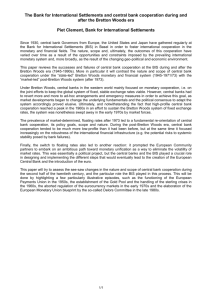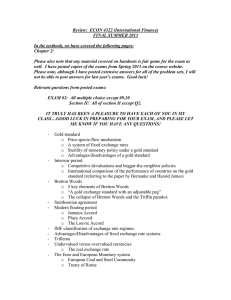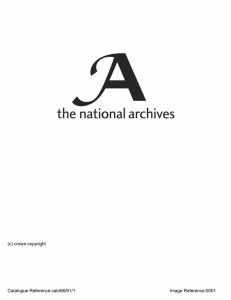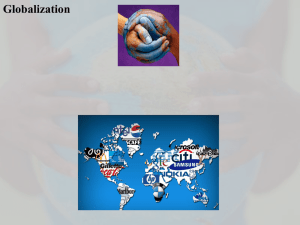Lecture 9: Globalization & international monetary regimes 1
advertisement
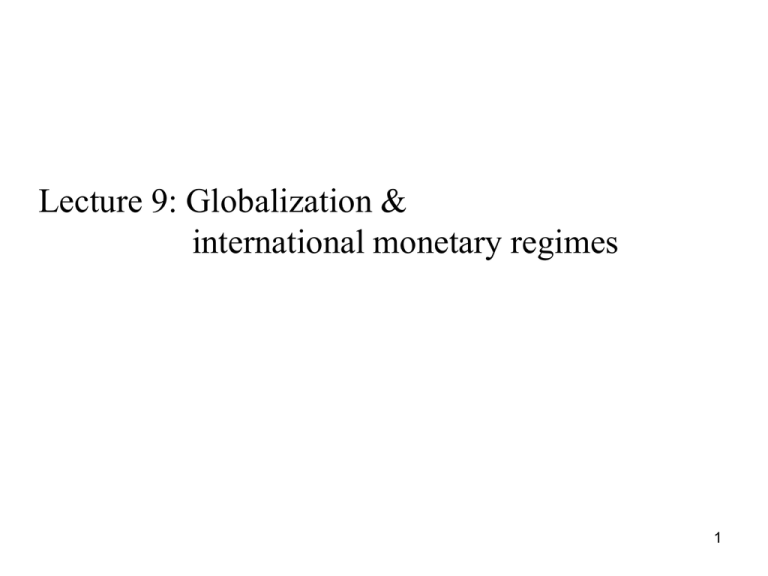
Lecture 9: Globalization & international monetary regimes 1 Starting observation: tremendous variation in international monetary regimes over time. First wave of globalization: gold standard floats Interwar: gold exchange standard floats Bretton Woods: (gold) dollar exchange standard Post-BW: dirty/crawling/hard pegs Introduction 2 Introduction 3 Key policy question here is whether countries fix their exchange rate—that is, peg it—or let it to be determined by the market—that is, float it. If we understand countries’ constraints and subsequent decisions, we might be able to explain big swings in regimes like: 1.) Gold standard (70%) versus pure float, 1913 2.) Gold standard (0%) versus pure float, 1939 Introduction 4 Need to examine in more detail the nations of the world’s experience with international monetary regimes. Allows us to answer the following questions: 1.) why do countries fix exchange rates? 2.) what allows countries to fix exchange rates? Introduction 5 First, need to be more explicit with what we mean by a fixed exchange rate regime. Simply, a policy objective adopted by a country to fix the relative value of their currency in terms of another currency or a basket of currencies. NER held (relatively) constant by intervention, Organizing principles 6 Second, need to consider why a country might peg its exchange rate with another currency. Simply, a peg might boost trade and capital flows, especially those flows of longer durations. Why? A reduction in uncertainty over payments and profits; also a reduction in transaction costs. Organizing principles 7 But do countries that have a peg trade more with each other (all else equal)? Use a gravity model: GDP1 GDP2 Trade12 n d12 ln(Trade12 ) 1 (GDP1 GDP2 ) 2 ln(d12n ) 3 ( peg12 ) Organizing principles 8 Organizing principles At the same time, gains from a peg are larger when cross-border transactions are larger in size. That is, a country is more likely to enter a pegged exchange rate with another country if they already trade a lot with one another. Thus, an endogeneity problem Organizing principles 10 If pegs stimulate trade and investment (and if these are good things), then why don’t all countries peg their exchange rates? Naturally, there are costs associated with a fixed exchange rate regime. This idea of comparing the benefits and costs Organizing principles 11 And so, what is this trilemma business? A trilemma is when there are three options and a choice must be made between them. Here, countries face the following menu: 1.) Fixed or floating exchange rates 2.) Free or constrained capital mobility Organizing principles 12 How to proceed? First, consider the implications of a fixed ER regime for monetary policy. Since nominal exchange rates are in part determined by interest rate differentials, central banks will have to change domestic interest rates Organizing principles 13 The HK dollar and USD as an example: iHK iUS but under a fixed exchange rate regime e EHKD /USD EHKD /USD EHKD /USD Organizing principles 14 Consider the conditions for equilibrium in the HK money market: the supply of real money balances = the demand for real money balances But uncovered interest parity implies that: Organizing principles 15 Now, notice everything is exogenously given: the price level (P), liquidity preferences (L), the nominal interest rate (i), and real income (Y). Thus, the central bank of HK’s hands are effectively tied in terms of monetary policy. But what if they tried to decrease the supply of HK dollars? Organizing principles 16 And this is the very essence of the trilemma… iHK e EHKD /USD EHKD /USD iUSA EHKD /USD e EHKD /USD EHKD /USD EHKD /USD iHK iUSA If HK tried to assert monetary policy autonomy, last condition would be an inequality Organizing principles 17 So, what are the combinations of economic policies available from the menu? 1.) A fixed ER regime, capital controls, and monetary policy independence; 2.) A fixed ER regime, international capital mobility, and monetary policy dependence Organizing principles 18 Putting it all together… The cost-benefit analysis for why countries peg. Benefits: 1.) greater trade and investment versus Costs: Organizing principles 19 Organizing principles As discussed previously, first wave of globalization as a period of unprecedented—and in some instances, unsurpassed—global flows. Also witnessed rise of a symmetric international monetary regime with no country at its center. In 1910, adherents of GS accounted for at least 70% of all nations, global GDP, and global trade. The rise and fall of the gold standard 21 What explains the rise of the gold standard? 1.) contingency/luck 2.) financial orthodoxy; market’s seal of approval 3.) its effects on trade and capital flows working in combination with network effects. The rise and fall of the gold standard Under GS, money supply was determined by the stock of gold for all intents and purposes; central banks only set mint prices of gold. Price of gold in England, PE, set at £4.24/oz; price of gold in France, PF, set at 107FF/oz. Gold then acts at the numeraire good for the two: mint prices imply a par exchange rate (Epar) The rise and fall of the gold standard 23 Arbitrage in international markets actually a stabilizing influence by helping keep exchange rates fixed; no need for government intervention. Deviations in E from Epar as arbitrage opportunities. If E was 25FF/£ in Paris versus Epar= 25.23FF/£ in London…what should you do if you had one ounce of gold in Paris? The rise and fall of the gold standard 24 As was suggested before, this was a fully decentralized system with: 1.) no formal principles; 2.) no formal international treaties, and 3.) no lender-of-last resort (much less a central bank in some countries; 1914/34 for NA). The rise and fall of the gold standard 25 Any trade imbalances were to be resolved through the price-specie flow mechanism: Implies monetary authorities are “hands-off”. The rise and fall of the gold standard With outbreak of WWI, countries suspend convertibility of currencies; GS shut down. But at its end, market participants along with governments expect nations to get back on gold once things return to normal. One underappreciated issue (by policymakers): differential rates of inflation meant that countries The rise and fall of the gold standard 27 The interwar period was characterized by the resurrection of the gold standard through the combination of: 1.) a desire to return to the pre-war level of global economic integration; and 2.) a desire to reclaim national status and prestige The rise and fall of the gold standard 28 Even though this was still not a centralized system, the period did mark: 1.) attempts to ease some of its constraints on Ms 2.) attempts to formalize its mechanisms; 3.) attempts to establish an international lenderof-last resort in the form of the BIS; The rise and fall of the gold standard 29 What explains this rapid fall of the resurrected gold standard? 1.) a potential breakdown in the price-specie flow mechanism: 2.) a definite change in political economy: The rise and fall of the gold standard 30 After WWII, general fear of currency instability of the interwar…but also a mistrust of the gold standard and its inflexibility. General desire to rebuild international trading system…but also acute political pressures for active macroeconomic policy. End result of “stability plus managed flexibility”: The rise and fall of Bretton Woods 31 Despite that this was a fully centralized system, market participants viewed it as a non-credible commitment on the part of governments. So much so that divergences between official ERs and (black/shadow) market rates were both large and widespread. The rise and fall of Bretton Woods 32 But for all this, collapse of the Bretton Woods system was a somewhat drawn-out process. 1.) capital controls of Bretton Woods era— although initially effective—were more easily evaded, and the trilemma reared its head again. 2.) The USD had become significantly The rise and fall of Bretton Woods 33 USD gold coverage plummeted in 1969/70 from roughly 50% to 20%, due to inflation from Vietnam War and the Great Society project. What is more, the US began running persistent trade deficits from 1971…the first time a trade deficit was ran since 1893. The rise and fall of Bretton Woods 34 Development of global capital markets 35 Leads to Smithsonian Agreement in 12/1971. Raised dollar price of gold (from $35 to $38/oz) and allowed for 2.25% trading bands as well. However, this was not enough; imposed no discipline on the US and was, thus, deemed non-credible by markets. The rise and fall of Bretton Woods 36 Floating ER then as the only way to preserve MP autonomy and co-exist with capital mobility. But as slide 3 demonstrates, only slightly more floating immediately after BW and substantially less floating after 1980. What explains decline of floating? The rise and fall of Bretton Woods 37 Notion of trilemma helps us how to think about international monetary regimes; also provides us a means to classify them in the past and present: 1.) Fixed exchange rates, capital controls, & monetary policy independence (BW); 2.) Fixed exchange rates, no capital controls, & monetary policy dependence (GS/interwar) Conclusion 38
